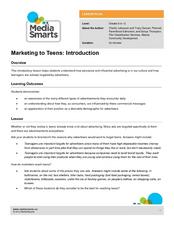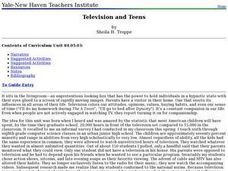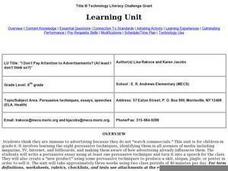ReadWriteThink
Critical Media Literacy: Commercial Advertising
Commercial advertising—we can't get away from it, but do we realize just how often we are being advertised to? With this lesson, scholars analyze mass media to identify how its techniques influence our daily lives. Learners browse...
Media Smarts
Violence on Film: The Ratings Game
Learn about film and TV ratings systems in Canada (includes a comparison to the MPAA system) and how they influence appropriate viewing for youths. A detailed commentary about the film Seven pointed at revealing flaws in ratings systems...
Curated OER
Advertising and Healthy Decisions
Students analyze alcohol and tobacco ads and create parodies of them. The eight lessons in this unit include discussions about why teens smoke or drink, the psychology behind the advertising, and writing persuasive letters to agencies,...
Curated OER
Rules of Conduct: Media Violence, Dating and Teenage Behavior
Students discuss the role of media in their lives and making decisions. In groups, they define violence and identify how it is represented in the type of entertainment they are accustomed to viewing. They compare and contrast behaviors...
Curated OER
Marketing to Teens: Introduction
An introductory lesson shows learners how pervasive and influential advertising is in our culture; particularly, how teenagers are actively targeted by advertisers. As teenagers, your young scholars already have all the information they...
Curated OER
T.V. Smarts
Students research visual messages by completing a media quiz. In this television programming instructional activity, students identify the many programs and commercials which use sexual imagery to sell their program or product. Students...
Visa
The Influence of Advertising
Pupils become informed consumers and citizens with this instructional activity on the influence of advertising, identifying basic advertising techniques and discriminating between fact and claim in modern advertisements and commercials.
Curated OER
Television and Teens
Students discuss the relationship teenagers have with the television. In groups, they watch different excerpts from various television shows and note every instance of violence including children. They also discuss the instances of...
Curated OER
Language Arts: Living in "The Matrix"
Students are able to identify, in a discussion mode, the ways in which the media uses persuasion to achieve their desired aims. They analyze, also in a discussion mode, the media's influence on our society by comparing media advertising...
Curated OER
Critical Consumerism: Videos and Teen Culture
Students analyze music videos as a study on teen culture. In this teen culture lesson, students view music videos and track a different aspect of the videos for male representation, female representation, racial representation,...
Curated OER
I Don't Pay Attention to Advertisements
Sixth graders examine the eight persuasive techniques, identifying them in all avenues of media including magazine, TV, Internet, and billboards, and making them aware of how advertising already influences them. They write an essay using...
Curated OER
"I Don't Pay Attention to Advertisements? (At least I don't think so?)"
Sixth graders study eight persuasive techniques that occur in a variety of media types. They write a persuasive essay and present it to the class. They create a "new product" for which they produce an advertisement using persuasive...
Curated OER
Creating Student Advertising
Students explore common advertising strategies used by the media. In this advertising instructional activity, students identify persuasive language in advertisements and construct their own persuasive ad.
Curated OER
When Building Up Leads to Breaking Down
Students examine where one develops his or her views about health and ways in which teen-agers exhibit these influences, focusing particularly on the rising trend of anabolic steroid use in teen-age girls.
Curated OER
Skin Deep and Other Teenage Reflections by Angela Shelf Medearis
Tenth graders explore how adolescents attempt to tain peer acceptance.














